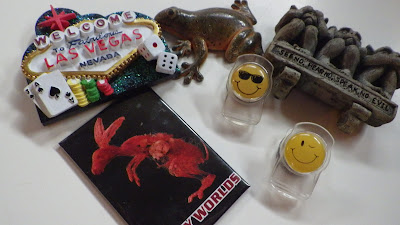Magnet Lab - Inquiry Based
In this lab, students are given a broad question and some equipment with which to design an experiment that answers the question. Students do not have papers to fill out and instead will focus on design and discovery. Data gathered can be written on the board and a discussion (or written) analysis can follow the experiement.
Question: How Strong Is Your Magnet?
Procedure: Using the equipment listed, design an experiement to determine the strength of your magnet.
Equipment: Magnet*, String, Weights, Cup, Paperclips, Rocks, Digital Scale or Balance
*Magnets can be any variety, and it can be more fun to give each group a different magnet. Refrigerator magnets can work, or you can order magnets from science supply companies (neodymium, alnico, ceramic). Students can often become very competitive about the project, comparing each groups strength.
I tend to collect a lot of magnets in my travels, you know the tourist magnets you can get from hotels and attractions. I ask relatives to pick them up for me too. You can use these magnets in the experiment and its add s bit of a personal touch and they will all perform differently. When gathering data, you can record them by the magnet, not the group name (Las Vegas, Gargoyles, Frogs)

Assorted magnets from around the world.
Procedure: Students usually come up with a variety of ways to text the magnets. If you have access to weights, those are great to use but they can be expensive. I've used a system of cups with rocks and marbles as a weight to simulate weights. The cups have holes punched in them so they can be attached to the string or the clips.
Some students will try to just loop the paperclip over the magnet, which will allow them to hold a large amount of weight. I've noticed that in the spirit of competition, other groups will loudly protest that their design is flawed, that the magnet is not really holding the weight, the human is.
Design Samples:
As with any inquiry lab, you should explore other methods and equipment to see how your students adapt.
I place the final weights on the board so that students can compare data and follow up with a class discussion.
Discussion Questions:
1. Why are some magnets stronger than others? (this can lead to another experiment or observation on size and type of magnet)
2. Were some designs better than others?
3. What was the purpose of the paperclip?
4. Design another experiment that tests the strength of the magnetic field. (This one can also be tested).
The National Academy of Sciences defines scientific inquiry in the National ScienceEducation Standards as:
…the diverse ways in which scientists study the natural world and propose explanations based on the evidence derived from their work. Scientific inquiry also refers to the activities through which students develop knowledge and understanding of scientific ideas, as well as an understanding of how scientists study the natural world.
